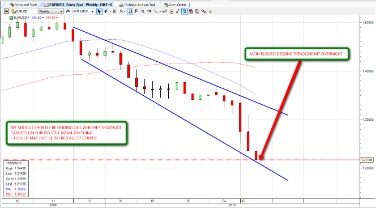- December 28, 2021
- Posted by: innovety
- Category: Forex Trading

If the Gravestone appears after a pricing downtrend, it can indicate that a price increase may follow (a bullish sign). However, since this occurrence is rare, most traders will typically wait until the following day to verify the possibility of a price uptrend after a Gravestone. However, an area of resistance is found at the high of the day and selling pressure pushes prices back down to the opening price. In particular, when it emerges after a bull run, most traders will take the Gravestone Doji as an indicator that a bearish reversal is about to take place, as in the chart below. This shows a Gravestone Doji occurring immediately before three bearish sessions, followed by a short pullback and a steeper drop.
It is used as a technical indicator that signals a potential reversal of the asset’s price. Many investors and traders turn to technical analysis to earn in the market and employ many instruments based on historical performance, price history, and trading volumes. This inverted T symbol, which shows up as a series of candlestick patterns, is bearish and suggests that the price action is undergoing a decline and indicates that a turnaround is likely. Understanding how the Gravestone Doji works, when to employ it, and how to combine it with various technical tools will enable you to limit your losses while trading. The Gravestone Doji is formed when the price closes at or near the same level as when it is opened. Due to this selling pressure prices are pushed back to the opening price for a certain period of time.
Gravestone Doji: Definition, How to Trade It, and Example
A Gravestone Doji is a bearish reversal candlestick pattern on a stock price trading chart. It is formed when the open, low, and closing gravestone doji meaning prices are all near each other with a long upper shadow. This scenario often comes just before a longer-term bearish downtrend.
How To Technically Analyze A Stock – Forbes
How To Technically Analyze A Stock.
Posted: Tue, 29 Aug 2023 07:00:00 GMT [source]
Since candlestick patterns are representations of market price movements, they tell us a lot about what happened, and how the market acted. While it’s nearly impossible to know exactly why a pattern was formed, it’s a really good exercise to try and analyze candlestick patterns a little further. The bulls try to force the market towards new highs during the session. However, the bears drive the price action to come close to the open at the end of the session.
Candlestick Basics
The Gravestone Doji Candlestick pattern is extremely uncommon, due to the particular requirements that must be fulfilled for it to form. A specific combination of an open and close that are close to or at the period low, a long upper shadow, and a tiny or nonexistent lower shadow are necessary for the pattern to appear. The Gravestone Doji Candlestick pattern is rarely observed in the market because these circumstances are not always met. The main components of a Gravestone Doji are the open, high, and close prices, which are at the same or nearly the same level, a long upper shadow, and no or very small lower shadow. Volume, existing market trends, and subsequent trading sessions are all critical in corroborating its signals. Throughout the trading day, the price of the security rises after opening, creating a high.
- The best time to trade using the Gravestone Doji candlestick pattern is when it is confirmed by other technical indicators and aligns with a trader’s overall strategy and risk management plan.
- The Gravestone Doji is considered one of the most significant Doji, which indicates a shift in the market sentiments from bearish to bullish.
- On the other hand, the Dragonfly Doji is a bullish pattern that can indicate an uptrend will occur.
- As the candle’s high, low, open, and closure (all four prices indicated) are all the same, this Doji pattern represents the utmost in indecision.
- Trading any financial instrument involves a significant risk of loss.
In case of an unclear situation, it is prudent to wait for a bearish reversal confirmation before initiating selling to expect more price falls. A gravestone doji may also be spotted in a downtrend with a bearish dominance. When the price of a security has shown a downward trend, it might signal an upcoming price increase.
Gravestone Doji In an Uptrend
After an uptrend, the Gravestone Doji can signal to traders that the uptrend could be over and that long positions could potentially be exited. While the Gravestone Doji and Dragonfly Doji have opposing meanings and are employed in different contexts, their shapes and attributes are similar. Both patterns have long shadows and tiny bodies, indicating market indecision. They can assist in identifying potential market reversal points and can be utilized with other tools for technical analysis to confirm trading decisions.
Its appearance signifies a shift in market sentiment, where buyers lose control, and sellers gain momentum. By incorporating the this pattern into a comprehensive trading strategy, traders can enhance their decision-making process and improve their overall trading outcomes. A Gravestone Doji is a type of candlestick pattern used in technical analysis to predict potential price reversals in financial markets. It is characterized by a long upper shadow and no lower shadow, indicating that the opening, low, and closing prices were the same while the high price was significantly higher.
What is a ‘Gravestone Doji’ Candlestick?
Or most commonly in the smallest of time frames – 15-minutes to tick level time frames. This opens up to two types of selling signals, a weak signal, and a strong signal based on where the patterns appear. Let’s look at an example https://g-markets.net/ of a gravestone doji with a resistance level. For example, if you saw a gravestone doji on a 1-week chart, that will provide a stronger indication of a reversal, much more than a gravestone doji appearing on a 15-minute chart.

However, traders must wait for the following candle to form to confirm the shift. It appears during a market uptrend, signaling the possibility of a bearish reversal. On the other hand, if a doji is formed at the bottom of a downtrend it is viewed by some traders as a bullish warning signal. However, since the opening price was also the lowest price point and buyers have tried to push the price up during the trading session, it can be a sign of fledgling positive momentum. In the world of technical analysis, candlestick patterns play a crucial role in helping traders identify potential trend reversals and market movements.
Gravestone Doji – The Graveyard in the Sky
The best place to put your stop is slightly above the wick (shadow) of the Gravestone Doji. In any trade, you never want to risk more than you are comfortable losing. The volatility levels in a market often have quite a significant impact on the performance of a strategy. Sometimes you want to limit a strategy to only place trades in a low volatility environment, and other times you want to do the opposite. Investopedia does not provide tax, investment, or financial services and advice.
However, by the end of the trading session, the price retreats and closes at or near the opening price. This pattern is marked by a long upper shadow, which represents the trading range between the highest traded price and the opening price. It appears when the open, closed, and low prices are the same or very close to each other, with a long upper shadow resembling an inverted “T” shape. You can check out our candlestick patterns cheat sheet to find more patterns like this to improve your forex trading capabilities. If a gravestone doji has appeared in an uptrend, this can be considered as a strong signal due to the spike of participants moving from buying to selling the market. It is well-known for amateurs to identify a gravestone doji in an open trading session, so they usually trade as soon as they identify it.
The Gravestone Doji suffers from the same reliability issues found in stock pricing chart visual patterns. As a precaution, traders should not act on a Gravestone Doji unless the next candle provides confirmation that a reversal is actually taking place. For example, there could be certain days of week or month that are extra bullish or bearish. The dragonfly doji pattern doesn’t occur frequently, but when it does it is a warning sign that the trend may change direction. Following a price advance, the dragonfly’s long lower shadow shows that sellers were able to take control for at least part of the period. While the price ended up closing unchanged, the increase in selling pressure during the period is a warning sign.
